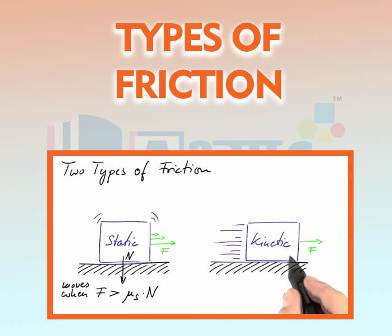Types of Friction











Types of Friction
Friction can be divided into following type
Static friction: When we apply a force on a body to make it move and it does not move, the force applied is balanced by the force of friction. Thus, “the force of friction in static (stationary) situation is self adjusting. Such force of is called static friction’
Sliding Friction: The force of friction acting between the two surfaces, when one of them just slides over the other surface with a uniform speed is called sliding friction. Sliding friction is less than the static friction
Rolling Friction: When a body is placed over the other bodies like roller or a wheel and is allowed to move this is called rolling friction. It is same as the sliding friction. So, whenever possible sliding friction can easily be replaced by rolling friction. This can be done by using wheels, roller bearings, ball bearings, etc.
Examples of Rolling Friction:
1. The suitcases and travelling bags are provided with small wheels. These wheels have very small amount of rolling friction which help easy movement of suitcase and travelling bags.
2. Roller skates are having small wheels which offer very small rolling friction and help skater to move fast.
Which of the following is example sliding friction ? | |||
| Right Option : D | |||
| View Explanation | |||
Which type friction offers least resistance ? | |||
| Right Option : B | |||
| View Explanation | |||
Which is the correct increasing order for different kinds of friction ? | |||
| Right Option : B | |||
| View Explanation | |||
Students / Parents Reviews [10]
My experience was very good with Abhyas academy. I am studying here from 6th class and I am satisfied by its results in my life. I improved a lot here ahead of school syllabus.

Ayan Ghosh
8thIt was a good experience with Abhyas Academy. I even faced problems in starting but slowly and steadily overcomed. Especially reasoning classes helped me a lot.

Cheshta
10thAbhyas Methodology is very good. It is based on according to student and each child manages accordingly to its properly. Methodology has improved the abilities of students to shine them in future.

Manish Kumar
10thOne of the best institutes to develope a child interest in studies.Provides SST and English knowledge also unlike other institutes. Teachers are co operative and friendly online tests andPPT develope practical knowledge also.

Aman Kumar Shrivastava
10thMy experience with Abhyas academy is very good. I did not think that my every subject coming here will be so strong. The main thing is that the online tests had made me learn here more things.

Hiya Gupta
8thAbhyas is a complete education Institute. Here extreme care is taken by teacher with the help of regular exam. Extra classes also conducted by the institute, if the student is weak.

Om Umang
10thAbout Abhyas metholodology the teachers are very nice and hardworking toward students.The Centre Head Mrs Anu Sethi is also a brilliant teacher.Abhyas has taught me how to overcome problems and has always taken my doubts and suppoeted me.

Shreya Shrivastava
8thBeing a parent, I saw my daughter improvement in her studies by seeing a good result in all day to day compititive exam TMO, NSO, IEO etc and as well as studies. I have got a fruitful result from my daughter.

Prisha Gupta
8thA marvelous experience with Abhyas. I am glad to share that my ward has achieved more than enough at the Ambala ABHYAS centre. Years have passed on and more and more he has gained. May the centre flourish and develop day by day by the grace of God.

Archit Segal
7thMy experience with Abhyas is very good. I have learnt many things here like vedic maths and reasoning also. Teachers here first take our doubts and then there are assignments to verify our weak points.
